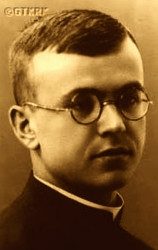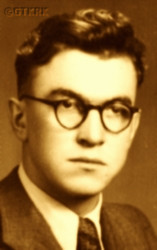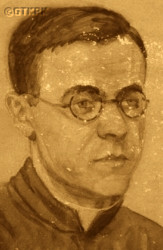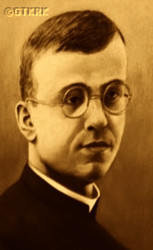Roman Catholic
St Sigismund parish
05-507 Słomczyn
85 Wiślana Str.
Konstancin deanery
Warsaw archdiocese, Poland
full list:
displayClick to display full list

searchClick to search full list by categories
wyświetlKliknij by wyświetlić pełną listę po polsku

szukajKliknij by przeszukać listę wg kategorii po polsku

Martyrology of the clergy — Poland
XX century (1914 – 1989)
personal data
religious status
Servant of God
surname
MACHAY
forename(s)
Ferdinand (pl. Ferdynand)
function
religious cleric
creed
Latin (Roman Catholic) Church RCmore on
en.wikipedia.org
[access: 2014.09.21]
congregation
Confederation of Oratories of Saint Philip Neri COrmore on
en.wikipedia.org
[access: 2013.05.19]
(i.e. Oratorian Fathers)
diocese / province
Tarnów diocesemore on
en.wikipedia.org
[access: 2013.05.19]
date and place
of death
05.06.1940

ZL Neu‐Wisnitzslave labour camp
today: Nowy Wiśnicz, Nowy Wiśnicz gm., Bochnia pov., Lesser Poland voiv., Poland
more on
en.wikipedia.org
[access: 2021.04.01]
alt. dates and places
of death
08.06.1940, 18.06.1940
details of death
After German and Russian invasion of Poland in 09.1939 and start of the World War II, after start of German occupation, volunteered to help in a hospital in Tarnów.
There, asked to hear the confession of a person in a Polish military uniform. During confession, „the soldier lamented the fall of Poland and suggested that he would commit suicide”. Consoling him, was to have told him that „a Polish army is already being organized in the West”. The „soldier” turned out to be a German informer.
Arrested by the Germans on 29.09.1939.
After 12 days of interrogations in Gestapo station in Tarnów where was beaten up jailed in Tarnów prison.
Next on 21.10.1939 transferred to prisons in Kraków (Montelupich Str.).
Finally on 14.05.1940 moved to ZL Neu‐Wisnitz forced slave labor concentration camp in Nowy Wiśnicz.
Tortured. The witness recalled that „a transport from Montelupich arrived [...] It included [...] Fr Machaj, an Oratorian Father from Tarnów [...] There was a lot of shouting and beating. Fr Machaj was especially beaten”.
Executed, in a reprisal for the escape of a Jewish prisoner — with 9 other prisoners, including 3 Jews — in a gorge in Brzezinka forest c. 500 m from the camp.
cause of death
mass murder
perpetrators
Germans
sites and events
ZL Neu‐WisnitzClick to display the description, Cracow (Montelupich)Click to display the description, TarnówClick to display the description, Sonderaktion KrakauClick to display the description, «Intelligenzaktion»Click to display the description, Ribbentrop‐MolotovClick to display the description, Pius XI's encyclicalsClick to display the description
date and place
of birth
09.12.1914Birth certification on:
skanoteka.genealodzy.pl
[access: 2025.03.18]

Jabłonkatoday: Jabłonka gm., Nowy Targ pov., Lesser Poland voiv., Poland
more on
en.wikipedia.org
[access: 2021.04.01]
parents
MACHAJ Ferdinand
🞲 ?, ? — 🕆 ?, ?

MOZARKA Veronica
🞲 ?, ? — 🕆 ?, ?
baptism
09.12.1914Birth certification on:
skanoteka.genealodzy.pl
[access: 2025.03.18]

Jabłonkatoday: Jabłonka gm., Nowy Targ pov., Lesser Poland voiv., Poland
more on
en.wikipedia.org
[access: 2021.04.01]
Transfiguration of the Lord RC church
presbyter (holy orders)
ordination
29.06.1938

Tarnówtoday: Tarnów city pov., Lesser Poland voiv., Poland
more on
en.wikipedia.org
[access: 2021.06.07]
Nativity of the Blessed Virgin Mary RC cathedral churchmore on
en.wikipedia.org
[access: 2025.03.14]
positions held
1938 – 1939
friar — Tarnówtoday: Tarnów city pov., Lesser Poland voiv., Poland
more on
en.wikipedia.org
[access: 2021.06.07] ⋄ Society's house (oratory), Oratorian Fathers Cor — also: chaplain at the hospital (1939)
1933 – 1938
student — Tarnówtoday: Tarnów city pov., Lesser Poland voiv., Poland
more on
en.wikipedia.org
[access: 2021.06.07] ⋄ philosophy and theology, Theological Seminary
20.06.1933
accession — Tarnówtoday: Tarnów city pov., Lesser Poland voiv., Poland
more on
en.wikipedia.org
[access: 2021.06.07] ⋄ Oratorian Fathers Cor
till 1933
pupil — Nowy Targtoday: Nowy Targ gm., Nowy Targ pov., Lesser Poland voiv., Poland
more on
en.wikipedia.org
[access: 2021.06.07] ⋄ Severin Goszczyński State Gymnasium
sites and events
descriptions
ZL Neu‐Wisnitz: After the Germans occupied Nowy Wiśnicz near Bochnia on 07.09.1939, the local penitentiary, established in c. 1783, after the First Partition of Poland by the Austrian Emperor, Joseph II Habsburg in the former monastery of the Discalced Carmelites, was transformed into a POW camp. By 15.12.1939, all POWs were sent to other camps. At that time, the Germans established the Germ. Zwangsarbeitslager (Eng. forced labor camp) / Germ. Zivilinternierungslager (Eng. transit camp for civilians) ZL Neu‐Wisnitz — administratively already located in the German–run occupational entity of the Germ. Generalgouvernement (Eng. General Governorate) — where it was intended to hold Poles arrested as part of the «Intelligenzaktion», an action to exterminate the Polish leadership, political and social activists, and representatives of the Polish intelligentsia. The first transport of c. 100 prisoners from Kraków was brought to the camp on 23.12.1939. It has not been possible to determine exactly how many such transports arrived at ZL Neu‐Wisnitz. Prisoners, organized in Germ. Kommando (Eng. work unit), slaved from dawn till dusk in the weaving mill, locksmith's shop, carpentry shop, laundry, camp kitchen, burying the dead. The inmates were harassed, beaten with bullwhips, hit with fists and boots, kicked, insulted, forced to stand for hours on the roll call square with raised hands, to „gymnastic exercises”. On 05.06.1940, in retaliation for a prisoner's escape, the Germans shot 10 „hostages” — fellow prisoners. On 20.06.1940 267 prisoners were transported to the new concentration camp KL Auschwitz, the formation of which was beginning. ZL Neu‐Wisnitz was liquidated and on 01.07.1940 in its place began to operate the heavy prison DZ Neu‐Wisnitz. (more on: www.sw.gov.plClick to attempt to display webpage
[access: 2025.02.18])
Cracow (Montelupich): Cracow penal prison, during occupation run by the Germans — from 28.02.1941 by Germ. Geheime Staatspolizei (Eng. Secret State Police, known as Gestapo. In 1940‐1944 Germans jailed there approx. 50,000 prisoners, mainly Poles and Jews. Some of them were transported to KL Auschwitz concentration camp, some were executed. After cease in war effort the prison was used by UB — a Polish unit of Russian NKVD — as a prison for Polish independence resistance fighters, some of which were subsequently sent to prisons and slave labour camps in Russia. (more on: en.wikipedia.orgClick to attempt to display webpage
[access: 2014.10.31])
Tarnów: The prison commissioned on 29.11.1926, considered at that time to be the most modern of its kind in Europe. During World War II and the German occupation, it functioned under the name of Germ. Deutsche Strafanstalt Tarnów (Eng. Penal Institution Tarnów) and was initially used as a transit camp for Polish prisoners of war, and then as a prison of the German political police Gestapo. In total, the Germans held about 25,000 Poles there. Many of them were shot by the Germans in the surrounding villages, others were transported to concentration camps. Among others, on 14.06.1940, a transport of 728 prisoners, who became the first prisoners of the newly established German concentration camp KL Auschwitz, was sent from the Tarnów prison. Later, about 50 such transports were sent to KL Auschwitz, and others to KL Sachsenhausen, KL Gross Rosen, KL Ravensbruck, KL Płaszów, and the children's camp in Łódź. After the end of the military operations of World War II and the beginning of the Russian occupation, political prisoners, opponents of the Commie‐Nazi regime of the Russian republic known as prl, were also held there. (more on: www.sw.gov.plClick to attempt to display webpage
[access: 2013.08.17])
Sonderaktion Krakau: German operation against Cracow intelligentsia, part of a broader «Intelligenzaktion» against Polish intelligentsia, carried out in 1939‐1940. On 06.11.1939 Germans arrested 183/4 Cracow professors from prestigiuous universities, mainly Jagiellonian University. They were jailed in Montelupich prison in Cracow prior to being sent to KL Sachsenhausen concentration camp. 4 days later on 10.11.1939 Germans arrested 25 Jesuits from Cracow College. They were also jailed in Montelupich prison and then transported to German concentration camps where 7 of them perished. (more on: en.wikipedia.orgClick to attempt to display webpage
[access: 2015.03.01])
«Intelligenzaktion»: German: «Intelligenzaktion» (English: „Intelligence Action”) — a German program of extermination of the Polish elite, mainly the intelligentsia and leadership layers, carried out from the beginning of the occupation in w 09.1939 to 04.1940, mainly in territories directly annexed to Germany, but also in the so‐called Germ. Generalgouvernement (Eng. General Governorate), where it was called «AB‐aktion». In the first phase, immediately after the beginning of the German occupation, during military operations carried out by the Germ. Wehrmacht (Eng. Armed Forces) and the genocidal units of the Germ. Einsatzgruppen (Eng. Operational Groups) of the Germ. Sicherheitspolizei (Eng. Security Police), i.e. SiPo, and Germ. Sicherheitsdienst des Reichsführers SS (Eng. Security Service of the Reichsführer SS), i.e. SD, organized by the Germ. Reichssicherheitshauptamt (Eng. Reich Main Security Office), i.e. RSHA, which followed the troops, carried out under the Germ. Unternehmen „Tannenberg” (Eng. Operation „Tannenberg”) — based on the so‐called Germ. Sonderfahndungsliste (Eng. Special Wanted Lists), i.e. proscription lists of Poles considered particularly dangerous to the Third Reich, prepared by the Zentralstelle II/P (Polen) unit of the German RSHA. Later, implemented by the German civilian occupation authorities and the genocidal unit of the Germ. Volksdeutscher Selbstschutz (Eng. Ethnic Germans Self‐Defense), whose members were Germ. Volksdeutsche (Eng. Ethnic Germans), i.e. representatives of the German minority in Poland. According to various sources, these lists, at the beginning of 09.1939, could have contained the details of 61,000—88,000 „dangerous” Poles — although these figures cannot be confirmed. In total, during this genocide, c. 50,000 teachers, Catholic priests, representatives of the landed gentry, freelancers, social and political activists, and retired military personnel were systematically and methodically murdered. Another 50,000 were sent to concentration camps, where only a negligible percentage survived. (more on: en.wikipedia.orgClick to attempt to display webpage
[access: 2014.10.04])
Ribbentrop‐Molotov: Genocidal Russian‐German alliance pact between Russian leader Joseph Stalin and German leader Adolf Hitler signed on 23.08.1939 in Moscow by respective foreign ministers, Mr. Vyacheslav Molotov for Russia and Joachim von Ribbentrop for Germany. The pact sanctioned and was the direct cause of joint Russian and German invasion of Poland and the outbreak of the World War II in 09.1939. In a political sense, the pact was an attempt to restore the status quo ante before 1914, with one exception, namely the „commercial” exchange of the so‐called „Kingdom of Poland”, which in 1914 was part of the Russian Empire, fore Eastern Galicia (today's western Ukraine), in 1914 belonging to the Austro‐Hungarian Empire. Galicia, including Lviv, was to be taken over by the Russians, the „Kingdom of Poland” — under the name of the General Governorate — Germany. The resultant „war was one of the greatest calamities and dramas of humanity in history, for two atheistic and anti‐Christian ideologies — national and international socialism — rejected God and His fifth Decalogue commandment: Thou shall not kill!” (Abp Stanislav Gądecki, 01.09.2019). The decisions taken — backed up by the betrayal of the formal allies of Poland, France and Germany, which on 12.09.1939, at a joint conference in Abbeville, decided not to provide aid to attacked Poland and not to take military action against Germany (a clear breach of treaty obligations with Poland) — were on 28.09.1939 slightly altered and made more precise when a treaty on „German‐Russian boundaries and friendship” was agreed by the same murderous signatories. One of its findings was establishment of spheres of influence in Central and Eastern Europe and in consequence IV partition of Poland. In one of its secret annexes agreed, that: „the Signatories will not tolerate on its respective territories any Polish propaganda that affects the territory of the other Side. On their respective territories they will suppress all such propaganda and inform each other of the measures taken to accomplish it”. The agreements resulted in a series of meeting between two genocidal organization representing both sides — German Gestapo and Russian NKVD when coordination of efforts to exterminate Polish intelligentsia and Polish leading classes (in Germany called «Intelligenzaktion», in Russia took the form of Katyń massacres) where discussed. Resulted in deaths of hundreds of thousands of Polish intelligentsia, including thousands of priests presented here, and tens of millions of ordinary people,. The results of this Russian‐German pact lasted till 1989 and are still in evidence even today. (more on: en.wikipedia.orgClick to attempt to display webpage
[access: 2015.09.30])
Pius XI's encyclicals: Facing the creation of two totalitarian systems in Europe, which seemed to compete with each other, though there were more similarities than contradictions between them, Pope Pius XI issued in 03.1937 (within 5 days) two encyclicals. In the „Mit brennender Sorge” (Eng. „With Burning Concern”) published on 14.03.1938, condemned the national socialism prevailing in Germany. The Pope wrote: „Whoever, following the old Germanic‐pre‐Christian beliefs, puts various impersonal fate in the place of a personal God, denies the wisdom of God and Providence […], whoever exalts earthly values: race or nation, or state, or state system, representatives of state power or other fundamental values of human society, […] and makes them the highest standard of all values, including religious ones, and idolizes them, this one […] is far from true faith in God and from a worldview corresponding to such faith”. On 19.03.1937, published „Divini Redemptoris” (Eng. „Divine Redeemer”), in which criticized Russian communism, dialectical materialism and the class struggle theory. The Pope wrote: „Communism deprives man of freedom, and therefore the spiritual basis of all life norms. It deprives the human person of all his dignity and any moral support with which he could resist the onslaught of blind passions […] This is the new gospel that Bolshevik and godless communism preaches as a message of salvation and redemption of humanity”… Pius XI demanded that the established human law be subjected to the natural law of God , recommended the implementation of the ideal of a Christian state and society, and called on Catholics to resist. Two years later, National Socialist Germany and Communist Russia came together and started World War II. (more on: www.vatican.vaClick to attempt to display webpage
[access: 2023.05.28], www.vatican.vaClick to attempt to display webpage
[access: 2023.05.28])
sources
personal:
www.filipini.gostyn.plClick to attempt to display webpage
[access: 2013.05.19], www.hagiographycircle.comClick to attempt to display webpage
[access: 2012.11.23], skanoteka.genealodzy.plClick to attempt to display webpage
[access: 2025.03.18], sw.gov.plClick to attempt to display webpage
[access: 2025.02.17], pl.wikipedia.orgClick to attempt to display webpage
[access: 2014.01.28]
original images:
ferdynand.filipini.euClick to attempt to display webpage
[access: 2016.05.30], www.kurierorawski.plClick to attempt to display webpage
[access: 2016.05.30], ferdynand.filipini.euClick to attempt to display webpage
[access: 2016.05.30], www.kurierorawski.plClick to attempt to display webpage
[access: 2016.05.30], www.sw.gov.plClick to attempt to display webpage
[access: 2022.12.10], www.kurierorawski.plClick to attempt to display webpage
[access: 2016.05.30], sw.gov.plClick to attempt to display webpage
[access: 2025.02.17]
LETTER to CUSTODIAN/ADMINISTRATOR
If you have an Email client on your communicator/computer — such as Mozilla Thunderbird, Windows Mail or Microsoft Outlook, described at WikipediaPatrz:
en.wikipedia.org, among others — try the link below, please:
LETTER to CUSTODIAN/ADMINISTRATORClick and try to call your own Email client
If however you do not run such a client or the above link is not active please send an email to the Custodian/Administrator using your account — in your customary email/correspondence engine — at the following address:

giving the following as the subject:
MARTYROLOGY: MACHAY Ferdinand
To return to the biography press below:
 Click to return to biography
Click to return to biography














